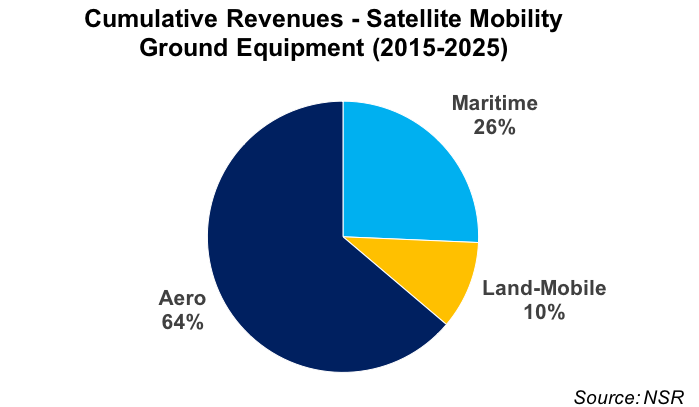Ground Segment:
The Forgotten
Link of
Satellite
Mobility
Nov 13th,
2016
by
Prateep
Basu, NSR
The rapid pace of
change in the
satellite industry
has consistently
pushed operators to
pivot their business
models, be it via
declines in capacity
pricing, more
competition, and
more recent growth
markets such as
aeronautical and
maritime. As the
industry and
end-users struggle
with arguments such
as Ku- vs. Ka-band
or GEO-HTS vs.
LEO-HTS, an
important and often
neglected part of
the success equation
is the ground
segment technology.
NSR’s Commercial
Satellite Ground
Segment report took
a deep dive in
assessing the
revenue opportunity
these changes in the
space segment bring
to the ground
segment industry.
The report found
that while mass
markets like DTH
drive overall
industry revenues
and equipment
shipments,
advancements in
satellite mobility
ground equipment –
end-user terminals
and antennas - form
critical steps
for the
industry to move
forward.
In the report,
both fixed and
mobile satellite
services were
studied, and NSR
found the
cumulative revenue
generation
opportunity for
satellite mobility
ground equipment by
the end of 2025 is
$14.1 billion.
An
interesting dynamic
noted in this study
(and in a previous
article) was that
despite contributing
only 0.5% of
cumulative equipment
shipments within the
global satellite
ground equipment
industry,
satellite mobility
ground equipment
will account for 14%
of cumulative
satellite ground
segment revenues
from 2015-2025.
Aeronautical VSATs
and equipment will
be the major
contributor to
satellite mobility
ground equipment
revenues, due to
their higher pricing
and the high rate of
market penetration
observed by NSR,
assisted largely by
the ‘need to be
connected’
attitude of flight
passengers driving
the demand and cheap
capacity in
abundance feeding
the supply.

The
challenges for the
satellite mobility
ground equipment
manufacturers are
however manifold,
with the technology
and economics curves
mostly not matching,
with the shelved
Boeing-Panasonic
being an example
where a Panasonic
top official quoted
the reason for this
decision being
airlines not
currently willing to
pay for the higher
cost of more
efficient antennas.
The onslaught of
satellite capacity
in different orbits
and frequency bands
is compounding the
problems for ground
equipment
manufacturers as
they grapple to
design precise
antenna pointing,
dynamic tracking
capabilities,
dual-band terminals,
fast beam switching,
gain stability, loss
in efficiency due to
oversaturation of
beams, and
trading-off on
issues like size,
weight, power and
heat, to name a few.
The problems
compound when these
units need to be
certified, and also
standardized in case
of Ka-band due to
the wide bandwidth
and different
frequencies of
operation, which
increases the lead
time to market and
henceforth becomes a
pivotal factor for
the market success
of current and next
generation HTS
systems.
But the satellite
industry has been
proactive lately in
accounting for
ground equipment
availability when
assessing their
technology-market
fit, as seen through
many industry
partnerships and
especially in the
case of emerging
flat panel antennas
for
communications-on-the-move,
with
Kymeta-Panasonic-Intelsat,
Phasor-Intelsat, and
Thinkom-GoGo being a
few notable
partnerships. As
managed services
become a central
part of business
strategy due to the
higher margins on
revenues through
value-adds and
offsetting of
depreciating
capacity costs,
NSR believes such
ground
equipment provider
partnerships for
co-development of
products will be
pivotal for closing
the business case in
emerging and new
market verticals in
satellite mobility.
Bottom
Line
New technology
calls for more new
technology, and the
satellite ground
equipment market,
being upstream
technology driven,
acts as a critical
support system for
the overall
satellite industry
ecosystem. NSR
research show this
opportunity is
massive, and
partnerships are
expected to pave the
way for faster
product development
to capitalize on
this opportunity.
One must however
not forget the
learning from past
experiences of the
satellite industry,
that the
fate of billions of
dollars invested by
satellite operators
globally effectively
lies in the timely
success of
technologically-economics
fit of the ground
equipment, making it
the unsung hero of
satellite mobility,
as it
undergoes
transformation, both
on the technological
and business model
fronts.